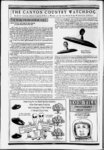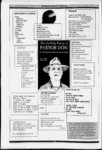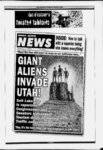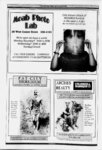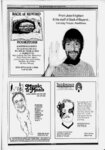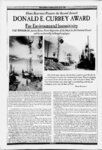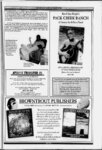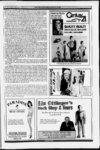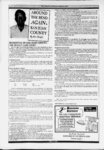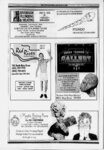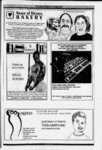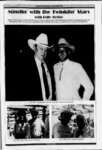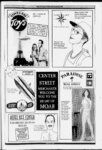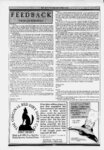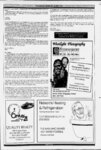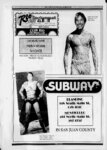| OCR Text |
Show Owen Severance Presents the Second Annual: DONALD E. CURREY AWARD For Environmental Insensitivity THE WINNER: Ms. Janette Kaiser. Forest Supervisor of the Manti-L-a and her aesthetically-challenge- d employees Sal National Forest. major eyesores that has been created in recent decades by our technological society is the communications tower. They are springing up in various forms all over the country tall, short, fat or skinny. Their visual obnoxiousness varies from slight to overwhelming, and they are multiplying faster than the State of Utah." Owen Severance One of the This award was established to recognize those who are following in the footsteps of the infamous Donald Currey. In the early 1960s , Donald Currey, a geographer from the University of North Carolina, obtained permission from the U.S. Forest Service to cut down a Bristlecone Pine tree to study the tree rings for a research project. W7iy he didn't use a coring tool, which is the normal way to study tree rings (and wouldn't permanently harm the tree), is not known. INhat is known is that he used a chain saw to cut down the largest Bristlecone Pine tree that he could find. It turned out to have ban the oldest living tree on earth about 4,900 years old. To "honor" his infamous deed, this award for environmental insensitivity has been created for those who have caused significant damage to the environment of the fouromers area. The degradation of the visual environment in the Four Comers region has not stopped since the area was first settled by Mormons in the late 1800s. Destruction accelerated through the uranium boom of the 50s and 60s. While many of the visual impacts that resulted from developments in our area could qualify for this award, I have decided to award two of the more recent examples of shameful disregard for the scenic values of southeastern Utah. One of the major eyesores that has been created in recent decades by our technological society is the communications tower. They are springing up in various forms all over the country tall, short, fat, or skinny. Their visual obnoxiousness varies from slight to overwhelming, and they are multiplying faster than the population of the State of Utah. towers The visibility of a tower is determined by its design. to be obnoxious have than "guyed" towers since they are much more visually made from heavy tubing to obtain their strength while "guyed" towers rely on "guy wires" to prevent their lighter construction from falling down. From a visual standpoint, "guyed" towers should be used whenever the communications site is in a visually sensitive area. Unfortunately for the scenic views in this area, towers are erected much more often than "guyed" towers. In the last two years. Forest Supervisor Janette Kaiser has had two golden on opportunities to greatly reduce the visual impacts of communications sites Forest 1986 views of the LaSal and Blue Mountains in Southeastern Utah. The Plan did not formally designate communications sites on the Forest, so "Self-supportin- "self-supportin- g" g" U " Environmental Assessments were prepared for the Bald Mesa and Aba jo Peak Communications Sites to bring them into compliance with Forest Service regulations. These GAs and the accompanying Decision Notices set the rules governing all aspects of the communications sites. The Bald Mesa Communications Site on the LaSal Mountains has long been an eyesore primarily because the towers are of the type. The been an opportunity for the Environmental Assessment for this site could have Forest Service to take a stand and reduce the visual impacts of this site. They could have mandated that all new towers would be of the "guyed" type and that towers would be replaced by "guyed" towers over the existing a period of years. Instead, Janette's Decision Notice mandated that all future towers will be No existing towers will be replaced with "guyed" towers. The Bald Mesa Communications Site has now been institutionalized as an "Official National Forest Eyesore." The situation on the Blue Mountains is even more disgusting. Abajo Peak, the highest point on the Blue Mountains, has been used as a communications site for decades; however, until recently, the towers were "guyed" towers and therefore not readily visible from Monticello or Highway 191. Then several years ago, without any EA or public input, the previous District Ranger and Forest Supervisor approved the construction of two 100' tall towers that violated the Visual Resource Protection section of the Forest Plan. The recent Environmental Assessment that formally designated the Abajo Peak Communications Site offered Janette the opportunity to correct that Forest Plan violation by requiring the towers to be replaced with "guyed" towers within a reasonable time and requiring that new towers would be of the "guyed" type. Instead, she chose to make these visually obnoxious towers a permanent part of the landscape by "redefining" the Forest Plan's section on visual resource protection. And, to compound the visual impacts of the site, she approved the construction of five more towers on Abajo Peak without any commitment that they be "guyed" towers. One of those towers can be ISC' tall much taller than the two obnoxious lCX? towers that are already in plaoe. Now Abajo Peak has also "self-supportin- "self-supportin- "self-supportin- EIGHTEEN g" g" g." "self-supportin- "self-supportin- g" g" |







